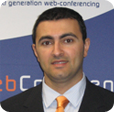A growing application of web conferencing these days is in “webcasting” live events. Organizations, trade shows, hotels and other AV (Audio Video) providers are slowly but surely getting accustomed with the idea of showing their events online in live and recorded formats. There is, of course, significant cost savings associated with this practice since a part of the audience no longer needs to travel to the physical event. It can also be regarded as a much “greener” solution for the same reason.
The latest and greatest example of such webcasting is Wells Fargo’s webcast of their Recognition event in Minneapolis, MN. A week earlier a paper had reported on Wells Fargo’s extravagant expenses in a Las Vegas event allegedly using government bailout money. This resulted in Wells Fargo cancelling some of the live events (read more… ) or reducing physical attendance by leveraging web conferencing. Note that Wells Fargo has denied some of the rumors and has defended the events (read more … ). Wells Fargo decided to use omNovia Technologies for its webcasting. On average, it costs over $700 ro send an employee to an event of this size. With more than 300 online viewers, Wells Fargo saved themselves a whopping $210,000 using this technology.
Webcasting live events or live-casting, as I call it, however, presents many challenges and should be distinguished from the typical web conferencing. Many webcasting solutions do not provide a true interactive environment. They simply provide a one-way communication, usually through video, with seconds of delay. Live-casting refers to a more complete experience in which online attendees can interact with the physical audience. In a Live-cast session, online attendees may ask questions via chat, voice or video. They may respond to questions or polls. They may download documents from the virtual room to their computers…
Differences between web conferencing and live-casting
- In a Live-cast session, the system needs to work with professional microphone and camera devices. Many heavy-duty devices do not work as PC microphone or webcams. For instance, a professional HD camera often used at live events produces very high resolution (in numbers of pixels) images that many web conferencing software cannot handle.
- While moderators of a webinar or web conferencing session can focus on the online session, live-cast sessions present almost 2 simultaneous presentations. You have to handle the live audience, audio, music, lighting or “workflow” in short at the same time as the online attendees’ experience. This can be a daunting task and at times contradicting to one another.
In future blogs, I will discuss points to consider when you want to perform a live-cast.
Can you name other applications of live-casting?


